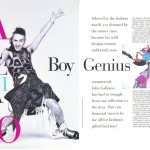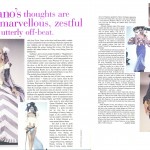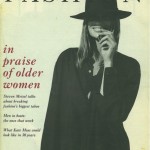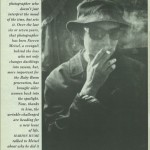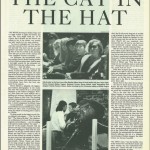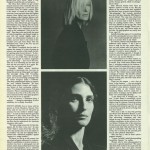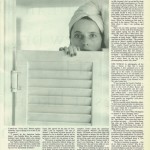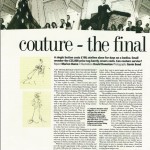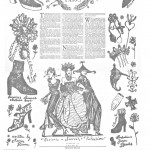The cat in the hat. Steven Meisel. The Independent on Sunday.
Haute Couture Paris ’93 – The IndePendent
Karl Lagerfeld The Independent
Kaiser Karl’s cul-de-sac: For ten years, Karl Lagerfeld has ruled international fashion. He made Chanel the status label for the Eighties, then took on every other spare label in sight. But now, the spirit of Coco Chanel is back in fashion, and Karl seems to have lost the plot
The Independent | Sunday, 29 August 1993
by Marion Hume
IN 1926, Jean Cocteau dashed off a simple sketch that summed up the state of fashion at a glance. In the foreground, a slender woman slouches comfortably in a simple jersey dress with only a squiggle of jewellery, while in the distance, a lumpen woman in a floor-length, fur-trimmed coat drags herself off the page and into history. ‘Poiret s’eloigne – Chanel arrive,’ Cocteau scribbled on the bottom of the drawing: Poiret – the favourite designer of the early Twenties – leaves and Chanel arrives.
And so she did, and went on – as we all know – to change the way women dress forever. When she cut a man’s pullover down the front, trimmed it with ribbon and shrugged it on because she was feeling chilly in Deauville, Coco Chanel was just making herself comfortable. But it was the beginning of a design revolution and the simple cardigan jackets with the high-cut armholes, those supple suits made from the men’s underwear jersey, encouraged women around the world to ease up, too.
If Cocteau were drawing today, it would be Karl Lagerfeld who was leaving. The modern woman in the foreground would be wearing something by, say, Ann Demeulemeester, or Calvin Klein, Martin Margiela or Rei Kawakubo. The woman in the background, however, would be wearing a scarcely recognisable classic Chanel jacket over a white shirt slung about with gold belts, a black tie, wrinkled leggings, Chanel-insignia furry snow boots, chain-handled quilted bag, CC choker, padlock pendant . . . so many bits and pieces, the back view could only be a relief.
For we are not now in a Chanel moment, or at least in a Chanel-Lagerfeld moment. We have been, all the way through the Eighties, which in fashion terms concluded with the spring/summer 1992 collections. But now the Chanel suit, with its gob-stopper gold buttons and boxy little jacket, looks as incorrect as a fur coat, and Karl Lagerfeld, who has always hurtled forward, suddenly looks like he’s stumbling down a cul-de-sac.
In the mid-Eighties, Lagerfeld’s Chanel shows, which took the breezy cream and navy dressing of Coco’s Deauville as their starting point, were delightful. By the late Eighties, they were sensational. Abbreviated suits in acidic colours, smothered in gold insignia, came marching down the catwalk to jarring vocals chanting ‘I am a very very rich girl . . .’ The clothes were gutsy, they were exuberant and, whether one liked or loathed them, they were right for the times.
But the times moved and Karl shot off on his tangent. In March this year, after the autumn/winter ready-to-wear shows for Chanel, Chloe, Fendi and Lagerfeld (all designed by Karl, and mostly monstrous) Women’s Wear Daily, the powerful fashion trade paper, wrote ‘The Lagerfeld juggernaut has stalled.’ At last month’s Chanel haute couture show, it showed no further sign of revival.
Out came micro-skirts over wobbling buttocks; waspish corsets that pushed breasts inwards and upwards so they jiggled like jellies on a plate, and gilded tweed bras (hands up who needs one). The show had begun with mock-iron gates thrust open at the head of the catwalk. At the end the gates were banged shut and padlocked. Then came an announcement: ‘You cannot go backstage. Mr Lagerfeld will be available shortly to receive your congratulations in the courtyard outside.’ Apart from some Japanese film crews, always keen for a quote, there wasn’t much of a queue.
All the signs are that Lagerfeld, who is said to spend a lot of time watching MTV in any one of the splendid 18th-century residences he has acquired, has lost the plot. Looking at MTV, you can understand why. Black rappers, with their oversized clothes, heavy gold chains, belts and optional guns, seem to have become muddled in his creative mind with the old Chanel classics. In the past, ‘the street’ has given Lagerfeld just a touch of inspiration; this time it seems to have overwhelmed him as he has attempted to translate young black style into fashion for the bourgeois white customer. The gap between rich and poor has grown larger, and the symbol of Lagerfeld’s Chanel – all those crossed CCs that came to stand for conspicuous consumption – have been replaced by PCs. Politically Correct Lagerfeld is not.
‘One might just as well tie a cheque around one’s neck’ Coco Chanel once said of women who wore huge diamond solitaires. She might have said the same about Lagerfeld’s suits.
The irony is that, as Lagerfeld’s influence wanes, it is the spirit of Coco Chanel which has arrived in fashion once more. Very much her own woman, Chanel had more on her daily agenda than keeping tricksy clothes in place. She cut her own fringe, pulled on a Breton fisherman’s jacket, wide pants and a T-shirt, tied a ribbon round her hair, slung on a string of pearls, stuffed her hands in her pockets and got on with her day. And that style, which mixed the readily available with the extraordinary, is in tune with the current ‘magpie’ school of dressing. After the fall of the short skirt and the loosening up of cut and shape, women are wearing comfortable clothes that make them feel feminine, modern, and in control of their sexuality. They are more confident about putting together their own style piecemeal, less concerned with status.
ONE SHOULDN’T forget, however, Lagerfeld’s enormous contribution to fashion – the greatest of which was that he took over the house of Chanel and shook it up. For almost 10 years he was probably the most influential
designer in the world. And while he can no longer be considered centre-stage, there is no sign that the Wertheimer family, which owns the Chanel name and employs Lagerfeld under contract, are still anything less than happy with him.
When he took over at Chanel in 1983, Lagerfeld told the fashion journalist Suzy Menkes, then of the Times: ‘I am a kind of fashion computer.’ Ten years later, who could doubt the truth of it? By then, 54 years old, he was designing two collections for Fendi, two for Chanel haute couture, two for Chanel pret- a-porter, two Chanel cruisewear collections for America, two collections for Chloe, two for the Karl Lagerfeld label, two for Karl Lagerfeld Cruise as well as overseeing the mass-market label, KL, and photographing advertising campaigns for Chanel and Karl Lagerfeld as well as other clients including Mercedes Benz. Is it hardly surprising that, finally, he seems to have overreached himself.
But if Lagerfeld’s power is slipping, Chanel, under the Wertheimers, is simply shifting its emphasis. Even if the basic suit been exploited almost to death, there is always that other treasure trove to plunder, the inspirational Chanel jewellery. This was the way Coco Chanel gave even the simplest suit a dash of individuality and splendour.
A new book by Patrick Mauries, published next month, focuses on Coco’s jewellery creations and ignores Karl Lagerfeld. In researching the well-worn ground (there have been hundreds of books about Chanel) Mauries has pulled out some of the lesser-known photographs, as well as charming illustrations by Eric for Vogue, by Marcel Vertes for Harper’s
Bazaar, by Christian Berard and Paul Iribe, and, most interestingly, he has included a previously unpublished portfolio of drawings by the prolific Jean Cocteau, recently discovered in an envelope marked ‘Chanel’.
Mauries’ scholarly book, unintentionally perhaps, reflects a shift in taste. Coco aficiandos – those who have hated Lagerfeld’s pillaging of her archive and have thus been at odds with fashion for almost a decade – are reclaiming their territory. The emphasis is now on taste, pared-down dressing, quality, authenticity. And with simplicity to the fore, it is jewellery instead of accessories – favourite pieces, whether precious or fake – which move across a variety of clothes and give the modern woman a touch of ornament and individual style.
For years, fake was fashionable. Now the Chanel company’s whispered plans to follow Mauries’ book later this year with the re-introducion of real jewellery, for the first time since 1937, suddenly starts to make some sense in these straightened times.
‘Jewellery by Chanel’ by Patrick Mauries is published on 6 Sept by Thames & Hudson

